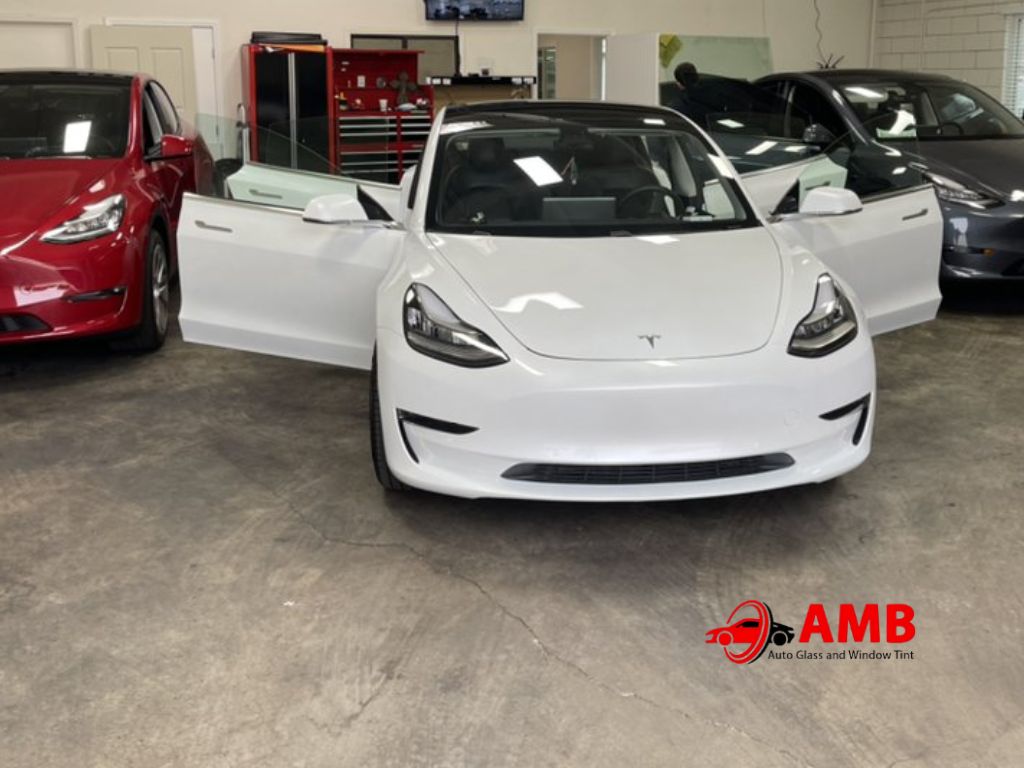When it comes to automotive window tinting, the debate between factory tint and aftermarket tint can be quite polarizing. Both provide significant benefits, but they also present unique challenges.
Factory tint, usually embedded within the glass, offers consistent quality but may not provide sufficient UV or heat protection.
Conversely, aftermarket tint, applied onto the existing glass, can offer enhanced protection and customization, but quality depends largely on the expertise of the installer.
This discourse aims to explore these aspects in detail, encouraging further scrutiny into the matter.
Key Takeaways
-
Factory tints offer limited UV and heat rejection compared to aftermarket tints, which can provide almost 99.9% UV rejection.
-
Aftermarket tints can double or more the heat rejection offered by factory tints, improving comfort and fuel efficiency.
-
Comparing factory and aftermarket tints, the latter does not interfere with onboard electronics, providing a seamless look and legal compliance.
-
Opting for professional installation of aftermarket tints ensures quality, durability, and compliance with local tint laws.
What is Factory Tint?
Factory tint, often referred to as privacy glass, is a type of window tinting that is integrated into the glass by automakers during the manufacturing process. The benefits of factory tint include enhanced privacy and a certain degree of glare reduction. However, factory tint limitations lie in its minimal heat rejection and UV protection, making the interior susceptible to temperature changes and sun damage.
In contrast, aftermarket tint advantages include superior heat rejection, UV protection, and durability. It comes with customization options, allowing vehicle owners to choose the level of tint that suits their needs and preferences. This enhanced protection and customization provided by aftermarket tint make it a popular choice despite the enduring appeal of factory tint.
What is Aftermarket Tint?
In contrast to factory tint, aftermarket tint is a high-quality film that is applied to the interior side of vehicle windows after the manufacturing process. It comes in a variety of tint options, each with its own degree of heat rejection, UV protection, and privacy enhancement.
Aftermarket tint offers superior heat rejection capabilities compared to factory tint, providing improved climate control within the vehicle. UV protection is another significant benefit, protecting the occupants from harmful ultraviolet rays that could cause skin damage. Privacy enhancement is an additional advantage, offering occupants a level of seclusion.
For best results and longevity, professional tinting installation is recommended, ensuring the tint is applied correctly and efficiently.
Quality Control and Consistency
Factory Tint: The factory-installed tint is an integral component of the vehicle’s glass, meticulously applied during production to ensure unrivaled quality control and consistency across all windows, including the front windows.
Implemented prior to glass installation, this meticulous tinting process strictly adheres to manufacturing protocols to achieve the desired darkness level and uniformity. The result is a flawless and harmonious aesthetic throughout the vehicle, with no disparities in tint intensity or application between the front windows and the remaining windows.
Aftermarket Tint: In contrast, aftermarket tinting is applied post-factory by third-party installers. The quality of aftermarket tinting can vary significantly depending on the expertise of the installer and the materials utilized. While some professionals uphold high-quality standards, others may use subpar materials or lack the necessary skills to achieve consistent and satisfactory outcomes.
Consequently, aftermarket tinting may display inconsistencies in darkness, application, and longevity, resulting in a less cohesive appearance and potentially diminished overall quality when compared to factory-installed tinting.
Legal Compliance
Factory Tint: Factory tinting typically adheres to legal regulations regarding window tint darkness established by automotive safety standards and local laws.
Manufacturers ensure that the level of tint applied during production meets or exceeds these legal requirements, providing consumers with tinted windows that comply with relevant regulations. This ensures that factory-tinted vehicles can be driven legally without the risk of fines or penalties for non-compliance with tinting laws.
Aftermarket Tint: On the other hand, aftermarket tinting may not always comply with legal standards, especially if the installer fails to adhere to local tinting regulations or if the chosen window tint darkness exceeds legal limits.
While reputable installers strive to comply with legal requirements, some may offer tinting options that are darker than what is permitted by law or use low-quality materials that deteriorate over time, resulting in a window tint that does not meet legal standards.
Consequently, vehicles with aftermarket tinting that do not comply with legal regulations may be subject to fines or restrictions on vehicle use, posing a potential risk to owners.
Customization Options
Factory Tint: Factory window tint options are typically limited to what the manufacturer offers as standard or optional equipment for specific vehicle models.
While factory tinting provides a basic level of tint darkness and UV protection, it may not offer the same level of customization or variety as aftermarket tinting. Consumers have limited flexibility in choosing the tint darkness or specialty films for factory-tinted vehicles, as the manufacturer predetermines these options.
Aftermarket Tint: Conversely, aftermarket tinting offers a wide range of customization options, allowing consumers to select the tint darkness, shade, and type of tint film that best suits their preferences and needs.
Professional installers can accommodate customization requests, including a specialty window film such as ceramic or metallic tinting for enhanced heat rejection and UV protection.
With aftermarket tinting, consumers can tailor the appearance and performance of their vehicle’s windows to their individual preferences, resulting in a more personalized and unique driving experience.
Durability and Warranty
Factory Tint: Factory tinting is often backed by a manufacturer’s warranty, providing consumers with assurance of quality and durability.
Since factory tinting is integrated into the vehicle’s glass during manufacturing, it undergoes stringent quality control measures to ensure longevity and performance. Manufacturers typically offer warranties that cover defects in materials or workmanship related to the factory tinting, providing added peace of mind to consumers.
Aftermarket Tint: The durability of aftermarket tinting can vary depending on the materials used and the expertise of the installer. While high-quality aftermarket tint films can offer durability comparable to factory tinting, inferior materials or improper installation techniques may result in premature fading, bubbling, or peeling of the tint film.
Many professional installers offer warranties on their aftermarket tinting services, covering defects in materials or workmanship for a specified period. However, the terms and coverage of aftermarket tint warranties may vary between installers and manufacturers, so consumers should carefully review the warranty details before proceeding with aftermarket tinting.
Cost Considerations
Factory Tint: When you opt for factory tinting, the cost is usually included in the overall price of the vehicle. It’s a standard or optional feature offered by the manufacturer. Because it’s applied during manufacturing, you don’t have to pay extra beyond the vehicle’s purchase price. This makes it a straightforward investment, saving you from aftermarket expenses for tinted windows.
Aftermarket Tint: On the other hand, aftermarket tinting adds to the vehicle’s cost since you need to pay separately for tinting materials and installation services. The total expense can vary based on factors like the type of tint film, the number and size of windows tinted, and the expertise of the installer.
While it may involve higher initial costs compared to factory tinting, aftermarket tinting allows for more customization according to your budget and preferences, including options for premium tint films with advanced features.
Aesthetics and Appearance
Factory Tint: Factory tinting gives your vehicle a smooth and consistent look that matches its design. It’s integrated into the glass during manufacturing, ensuring a seamless appearance across all windows. This adds a modern and classy touch to your vehicle while offering practical benefits like privacy, reducing glare, and protecting from UV rays.
Aftermarket Tint: With aftermarket tinting, you can customize your windows’ appearance with various tint darkness levels, shades, and specialty films. Whether you prefer a subtle or bold tint, aftermarket options let you tailor your vehicle’s look to your style.
However, it’s important to note that aftermarket tinting may not always match the seamless and consistent appearance provided by factory tinted glass. Beyond aesthetics, aftermarket tinting also improves privacy, reduces glare, and enhances UV protection, adding both style and functionality to your vehicle.
Installation Process and Time
Factory Tint: Factory tinting comes pre-applied to the vehicle’s glass during manufacturing, saving consumers time and effort. There’s no need for additional appointments or visits to a professional installer since it’s seamlessly integrated into the production process. This means no disruptions to your schedule.
Aftermarket Tint: Getting aftermarket tinting involves scheduling a visit with a professional installer, which can take a few hours depending on the complexity. The process starts with cleaning and prepping the windows, followed by applying the tint film using specialized tools.
Professionals ensure a smooth finish and proper adhesion. While it may take longer than factory tinting, aftermarket tinting offers customization options and expert assistance to achieve desired results.
Conclusion
Both factory tinted windows and aftermarket tinting fulfill the objectives of improving privacy, minimizing glare, and shielding against UV radiation. However, they diverge notably in quality, legal compliance, customization possibilities, longevity, pricing, visual appeal, and installation method.
Grasping these disparities is crucial for making a well-informed choice that harmonizes with your preferences, financial constraints, and pertinent regulations.
Whether you prefer the ease and uniformity of factory tinted windows or the adaptability and personalization offered by aftermarket tinting, being aware of the distinctions enables you to select the option that most aptly caters to your requirements and aesthetic preferences.
Ready to enhance your vehicle’s aesthetics and comfort with professional window tinting? Contact AMB Auto Glass and Window Tint today to schedule your appointment and experience the difference with us!

